Lithium Compound Market Size and Trends
The lithium compounds market is estimated to be valued at USD 8.78 Bn in 2025 and is expected to reach USD 21.45 Bn by 2032, growing at a compound annual growth rate (CAGR) of 13.6% from 2025 to 2032.
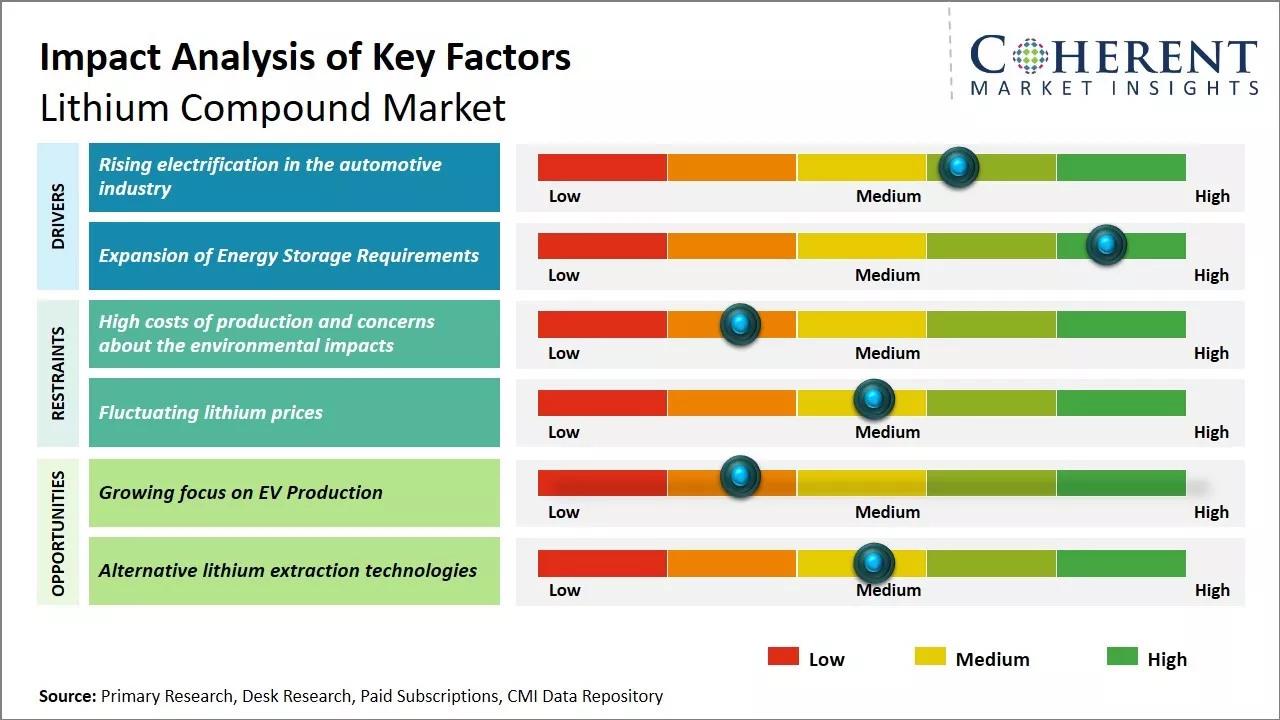
Discover market dynamics shaping the industry: Download Free Sample
The demand for lithium compounds is projected to grow significantly during the forecast period owing to the increasing sales of electric vehicles worldwide. Key factors, such as stringent emission norms, rising environmental concerns, and supportive government policies and incentives, are favoring the adoption of electric mobility over conventional vehicles. As lithium compounds play a key role in lithium-ion batteries that power electric vehicles, their demand is expected to rise in tandem with EV sales over the next few years.
Rising electrification in the automotive industry
The automotive sector has been a major driving force contributing to the growth of the global lithium compounds market. For instance, according to data published by the Automobile Sector resulted in 5.41% of the total FDI inflow as per the September 2023 DPIIT Report. The lithium compounds market is expected to witness significant growth in the coming years due to the rising demand for lithium-ion batteries from the automotive industry. There is a global push for more environment-friendly vehicles and a growing concern about emissions from internal combustion engine vehicles. Many countries have announced plans to ban the sales of new gasoline and diesel cars and are encouraging producers to shift towards electric vehicles. Major automakers are heavily investing in electric vehicle development and production to cater to this growing demand.
Market Concentration and Competitive Landscape
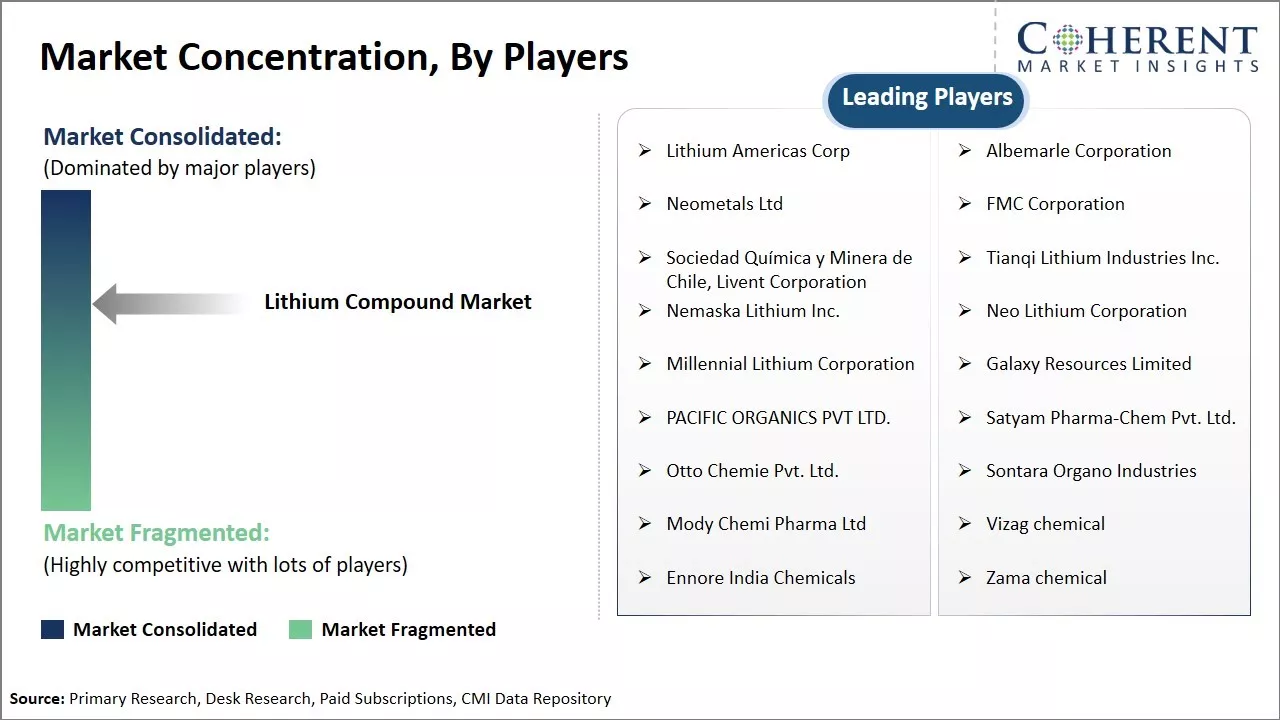
Get actionable strategies to beat competition: Download Free Sample
Expansion of Energy Storage Requirements
Another key factor leading to the increased demand for lithium compounds is the rapidly expanding global energy storage market driven by the rising integration of renewable energy sources like solar and wind. For instance, according to data published by IEA in 2022, the installed grid-scale battery storage capacity is expected to expand 35-fold between 2022 and 2030 to nearly 970 GW. Additionally, intermittent supplies from renewables require efficient energy storage technologies to balance power grids and ensure reliability of electricity supply. Lithium-ion batteries have emerged as the preferred choice for utility-scale energy storage projects due to their suitability for high discharge power applications and long operational life. Many countries and regions have set ambitious targets to increase the share of renewables in total power generation which will necessitate the deployment of large amounts of energy storage capacity.
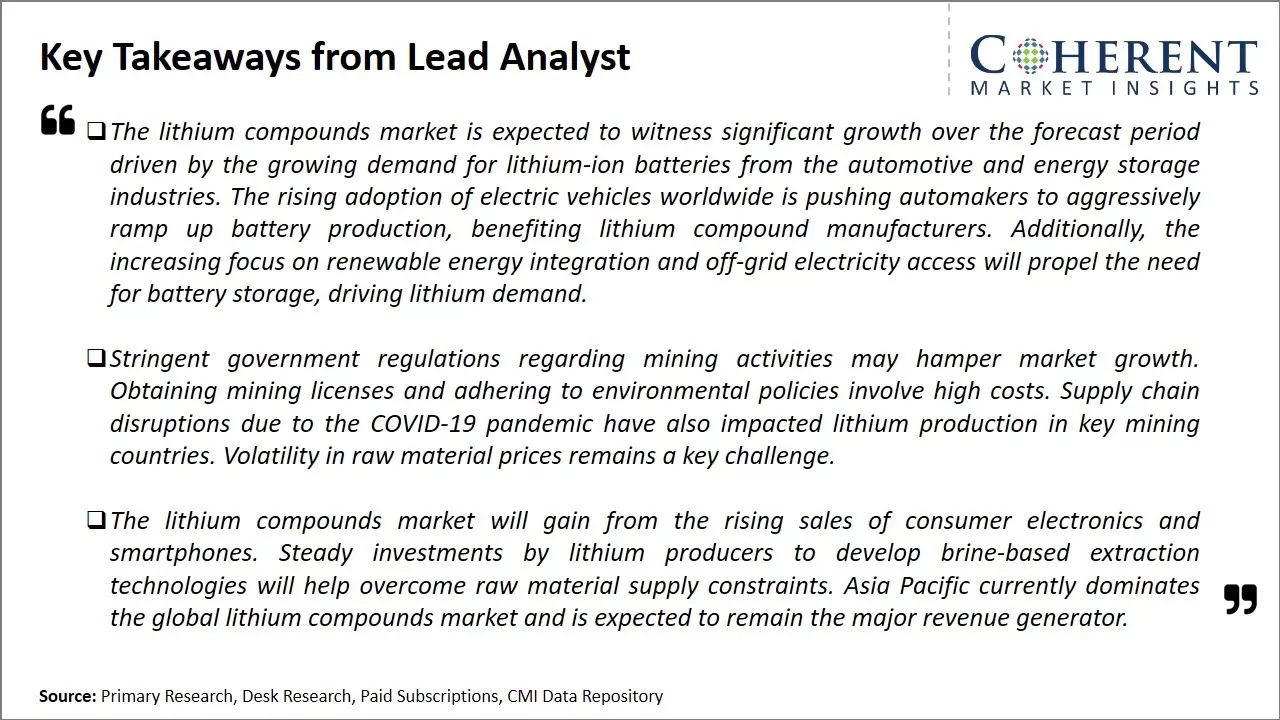
To learn more about this report, Download Free Sample
Market Challenges: High costs of production and concerns about the environmental impacts
The lithium compounds market faces several challenges. As the demand for lithium continues to rise sharply due to its use in lithium-ion batteries for EVs and electronics, suppliers are struggling to find ways to meet the growing needs. Furthermore, overdependence on major reserves in countries like Chile, Argentina, and Australia makes the market vulnerable to geopolitical risks. High costs of production and concerns about the environmental impacts of mining also impede the growth of supply. Sustaining long-term supplies at reasonable costs while addressing sustainability issues remains a key challenge for stakeholders.
Market Opportunities: Growing focus on EV Production
The lithium compounds market also presents substantial opportunities. As the EV revolution continues to unfold over the coming decades, the lithium demand is projected to multiply manifold, opening up huge opportunities for suppliers. Suppliers are exploring new production methods and alternative sources of lithium like seawater to boost supplies.
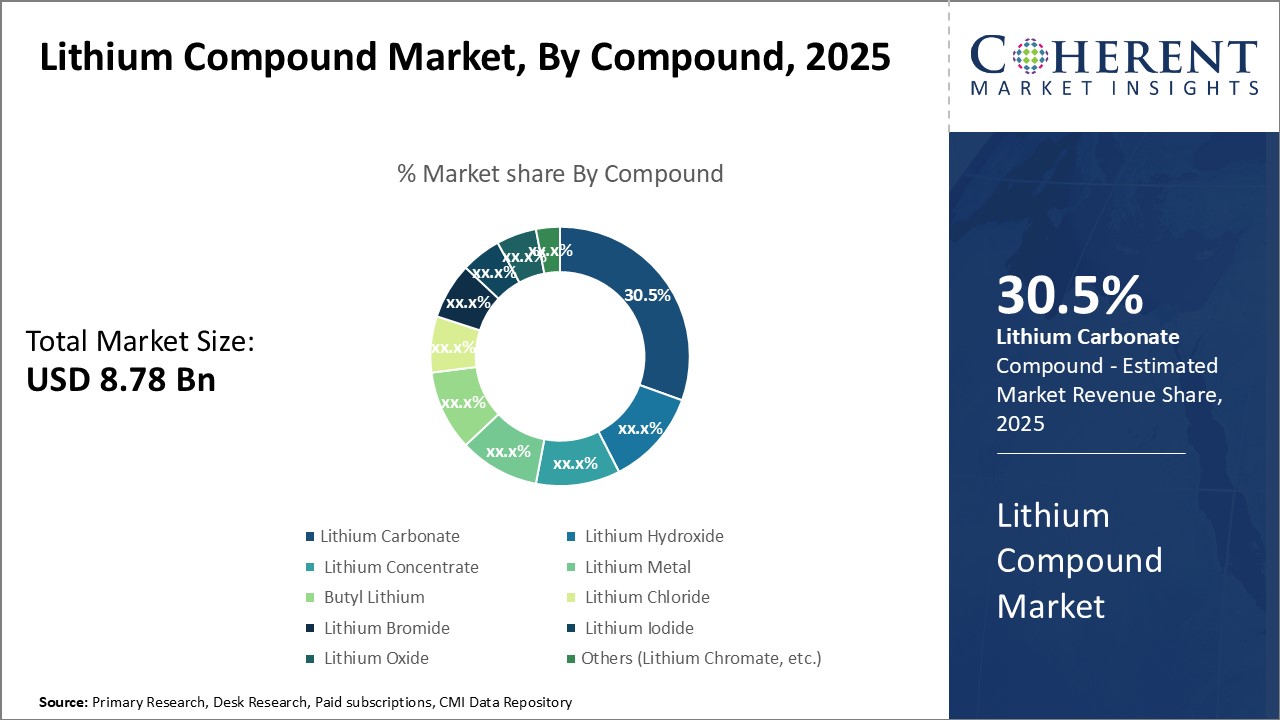
Discover high revenue pocket segments and roadmap to it: Download Free Sample
Insights, By Compound: The Rise of Rechargeable Batteries
In terms of compound, lithium carbonate contributes 30.5% of the market share owing to its widespread use in the manufacturing of lithium-ion batteries. Over the past decade, the demand for rechargeable batteries has grown exponentially due to their applications in various consumer electronics such as smartphones, laptops, power tools, and electric vehicles. Lithium carbonate is a key component in the cathodes of lithium-ion batteries which gives them higher energy density compared to other battery technologies. It allows manufacturers to develop smaller, lighter, and more powerful batteries. As the performance and capacity of such batteries continue to improve through ongoing research and development, more applications are expected to switch to lithium-ion technology, meeting the ever-growing demand for prolonged battery life. The continuous expansion of the consumer electronics industry as well as the rising electric vehicle sector has significantly increased the consumption of lithium carbonate and is expected to drive its market dominance over the forecast period.
Insights, By Application: Materials Engineering for a Greener Future
In terms of application, li-ion batteries contribute 30.5% of the market share owing to its extensive usage in specialty applications. Lithium-ion (Li-ion) batteries are a type of rechargeable battery that use the reversible intercalation of Li+ ions into the anode during discharge and into the cathode during charging. They are characterized by higher specific energy, energy density, energy efficiency, longer cycle life, and longer calendar life compared to other rechargeable batteries. Li-ion batteries have had a significant impact on various technologies, enabling portable consumer electronics, electric cars, and grid-scale energy storage. They are used in applications such as consumer electronics, power tools, electric vehicles, and grid energy storage. The batteries consist of an anode, cathode, separator, electrolyte, and two current collectors. The most common combination of materials for the electrodes is lithium cobalt oxide for the cathode and graphite for the anode. Li-ion batteries have advantages such as high energy density, high voltage, low maintenance, and no memory effect. However, they also have some disadvantages including the potential for thermal runaway and the need for protection circuits to maintain safe operation. This is expected to further stimulate the demand for the compound in the coming years.
Insights, By End-use Industry: Growth in Food Processing Industries
In terms of end-use industry, automotive contributes 50.5% of the lithium compounds market led by the booming electric vehicle sector. Over the last decade, electric vehicles have rapidly gained popularity due to lower operating costs and carbon emissions compared to conventional fuel-based automobiles. The growing concerns over climate change and implementation of stringent emission norms by governments worldwide have prompted major automakers to invest heavily in developing affordable EVs for mass markets. Lithium compounds play a pivotal role in enabling higher vehicle range and quicker charging times through continuous battery technology improvements. Growing infrastructure support in terms of public charging stations and subsidized initiatives have further boosted EV adoption rates. Additionally, autonomous driving relying on advanced computing also depends heavily on lithium ion power sources. With the e-mobility wave showing no signs of slowing down, the demand for lithium compounds from the rapidly expanding automotive industry is expected to surge exponentially over the coming years.
Regional Insights
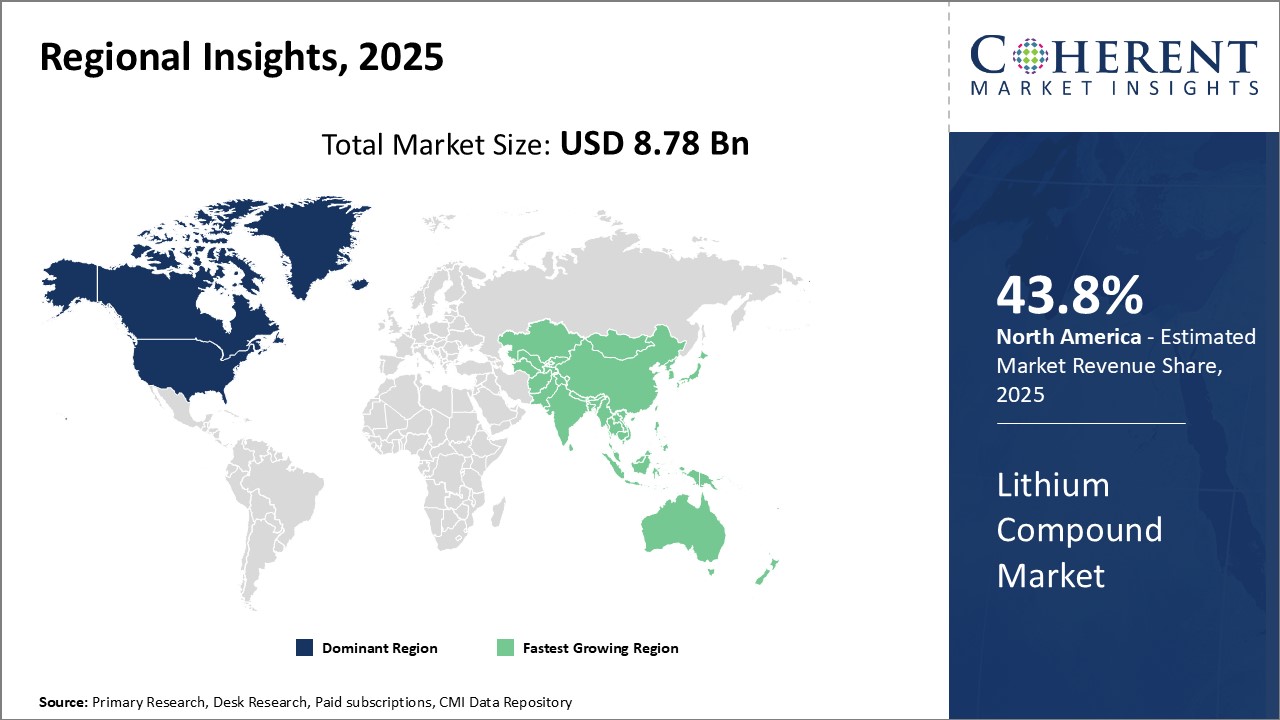
Need a Different Region or Segment? Download Free Sample
North America has established itself as the dominant region with a market share 43.8% in the global lithium compounds market. The region is home to several key players that have been actively involved in the lithium business for decades. Major lithium producers, such as Albemarle and Livent, have a strong foothold in the region and have established integrated operations across the lithium value chain from mining and production to battery-grade lithium compounds. The region also has a sizable lithium reserve base and is a net exporter of lithium, meeting the global demand. Moreover, the growing electric vehicle market in the U.S. and Canada is driving significant demand for lithium compounds from the battery industry.
The Asia Pacific region, especially China, is projecting impressive growth and is emerging as the fastest growing regional market for lithium compounds with a market share of 55.5%. Several large-scale lithium mining projects and lithium compound manufacturing facilities are coming online to meet the rising demand from the burgeoning electric vehicle and energy storage markets within the region. China dominates the global lithium-ion battery supply chain and is utilizing its economic might to secure critical raw materials including lithium. Domestic lithium producers are expanding and integrating operations with support from the government to fuel regional ambitions of being self-reliant in the new energy supply chain. Other Asia Pacific nations like South Korea and Japan are also ramping up investments to boost lithium security and self-sufficiency. The region already has a competitive advantage due to lower manufacturing and logistics costs.
Market Report Scope
Lithium Compound Market Report Coverage
| Report Coverage | Details | ||
|---|---|---|---|
| Base Year: | 2024 | Market Size in 2025: | USD 8.78 Bn |
| Historical Data for: | 2020 To 2024 | Forecast Period: | 2025 To 2032 |
| Forecast Period 2025 to 2032 CAGR: | 13.6% | 2032 Value Projection: | USD 21.45 Bn |
| Geographies covered: |
|
||
| Segments covered: |
|
||
| Companies covered: |
Lithium Americas Corp, Albemarle Corporation, Neometals Ltd, FMC Corporation, Sociedad Química y Minera de Chile, Livent Corporation, Tianqi Lithium Industries Inc., Nemaska Lithium Inc., Neo Lithium Corporation, Millennial Lithium Corporation, Galaxy Resources Limited, PACIFIC ORGANICS PVT LTD. , Satyam Pharma-Chem Pvt. Ltd. , Otto Chemie Pvt. Ltd., Sontara Organo Industries, Mody Chemi Pharma Ltd, Vizag chemical, Ennore India Chemicals, and Zama chemical |
||
| Growth Drivers: |
|
||
| Restraints & Challenges: |
|
||
Uncover macros and micros vetted on 75+ parameters: Get instant access to report
Lithium Compound Industry News
- On June 11, 2021, Ganfeng Lithium announced to increase in its Li2CO3 product by 600,000 tons original time as demand for the commodity used in electric-vehicle batteries increased. The company will vend around USD 630 million in new shares to boost capacity and fund implicit investments.
- On April 27, 2022, SQM increased its lithium carbonate production capacity to 180,000 metric tons per year, while working towards 210,000 tons by early 2023
- In September 2022, Lithium Americas Corporation entered into a strategic collaboration agreement with Green Technology Metals (GT1). The collaboration aimed to leverage the expertise of both parties towards the joint development of a strategically located, integrated lithium chemicals business in North America.
- In February 2023, Lithium Americas Corporation announced the closing of the initial US$320 million tranche of the previously announced $650 million equity investment by General Motors (GM). This investment made GM Lithium the largest shareholder and offtake partner in the U.S. The proceeds from GM's investment will be used to accelerate the development of the Thacker Pass project in Nevada, which is the largest known lithium resource in the U.S. and is fully permitted to begin construction. Lithium Americas expects to close the second and final tranche of the investment following the anticipated separation of its U.S. and Argentine businesses in the second half of 2023.
*Definition: The lithium compounds market consists of various industrial lithium chemicals that are used to produce lithium-ion batteries for electric vehicles, consumer electronics, and energy storage systems. Some of the major lithium compounds traded in this market include lithium carbonate, lithium hydroxide, lithium chloride, lithium fluoride, lithium bromide, and others. These lithium compounds are used as precursors to manufacture cathode and electrolyte materials for lithium-ion batteries.
Market Segmentation
- Compound Insights (Revenue, USD Bn & KT, 2020 - 2032)
- Lithium Carbonate
- Lithium Hydroxide
- Lithium Concentrate
- Lithium Metal
- Butyl Lithium
- Lithium Chloride
- Lithium Bromide
- Lithium Iodide
- Lithium Oxide
- Others (Lithium Chromate, etc.)
- Application Insights (Revenue, USD Bn & KT, 2020 - 2032)
- Li-ion Batteries
- Cement & Concrete
- Metallurgy
- Lubricants
- Glass & Ceramics
- Polymers
- Specialty Inorganics
- Others (Medicines, etc.)
- End-use Industry Insights (Revenue, USD Bn, 2020 - 2032)
- Food & Beverages
- Aerospace and Defence
- Automotive
- Oil and Gas
- Energy, Building & Construction
- Chemical Industry
- Others (Healthcare and Medical Industry, etc.)
- Regional Insights (Revenue, USD Bn, 2020 - 2032)
-
- North America
- U.S.
- Canada
- Latin America
- Brazil
- Argentina
- Mexico
- Rest of Latin America
- Europe
- Germany
- U.K.
- Spain
- France
- Italy
- Russia
- Rest of Europe
- Asia Pacific
- China
- India
- Japan
- Australia
- South Korea
- ASEAN
- Rest of Asia Pacific
- Middle East & Africa
- GCC Countries
- Israel
- Rest of Middle East & Africa
- North America
- Key Players Insights
- Lithium Americas Corp
- Albemarle Corporation
- Neometals Ltd
- FMC Corporation
- Sociedad Química y Minera de Chile, Livent Corporation
- Tianqi Lithium Industries Inc.
- Nemaska Lithium Inc.
- Neo Lithium Corporation
- Millennial Lithium Corporation
- Galaxy Resources Limited
- PACIFIC ORGANICS PVT LTD.
- Satyam Pharma-Chem Pvt. Ltd.
- Otto Chemie Pvt. Ltd.
- Sontara Organo Industries
- Mody Chemi Pharma Ltd
- Vizag chemical
- Ennore India Chemicals
- Zama chemical
Share
Share
About Author
Vidyesh Swar is a seasoned Consultant with a diverse background in market research and business consulting. With over 6 years of experience, Vidyesh has established a strong reputation for his proficiency in market estimations, supplier landscape analysis, and market share assessments for tailored research solution. Using his deep industry knowledge and analytical skills, he provides valuable insights and strategic recommendations, enabling clients to make informed decisions and navigate complex business landscapes.
Missing comfort of reading report in your local language? Find your preferred language :
Transform your Strategy with Exclusive Trending Reports :
Frequently Asked Questions
EXISTING CLIENTELE
Joining thousands of companies around the world committed to making the Excellent Business Solutions.
View All Our Clients
